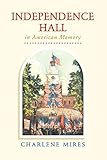Independence Hall in American Memory / Charlene Mires.
Material type: TextPublisher: Philadelphia : University of Pennsylvania Press, [2015]Copyright date: ©2002Description: 1 online resource (368 p.) : 60 illusContent type:
TextPublisher: Philadelphia : University of Pennsylvania Press, [2015]Copyright date: ©2002Description: 1 online resource (368 p.) : 60 illusContent type: - 9780812222821
- 9780812204230
- Historic sites -- Social aspects -- United States
- Memory -- Social aspects -- United States
- National characteristics, American
- Public history -- United States
- Books of Regional Interest
- HISTORY / United States / Revolutionary Period (1775-1800)
- American History
- American Studies
- Books of Regional Interest
- 974.811
- F158.8.I3
- online - DeGruyter
- Issued also in print.
| Item type | Current library | Call number | URL | Status | Notes | Barcode | |
|---|---|---|---|---|---|---|---|
 eBook
eBook
|
Biblioteca "Angelicum" Pont. Univ. S.Tommaso d'Aquino Nuvola online | online - DeGruyter (Browse shelf(Opens below)) | Online access | Not for loan (Accesso limitato) | Accesso per gli utenti autorizzati / Access for authorized users | (dgr)9780812204230 |
Frontmatter -- CONTENTS -- Introduction -- 1. Landmark: A British Home for the American Revolution -- 2. Workshop: Building a Nation -- 3. Relic: Survival in the City -- 4. Shrine: Slavery, Nativism, and the Forgotten History of the Nineteenth Century -- 5. Legacy: Staking Claims to the Past Through Preservation -- 6. Place and Symbol: The Liberty Bell Ascendant -- 7. Treasure: Eighteenth-Century Building, Twentieth-Century City -- 8. Anchor: A Secure Past for Cold War America -- 9. Prism: Redefining Independence for a Third Century -- 10. Memory: The Truths We Hold to Be Self-Evident -- Notes -- Index -- Acknowledgments
restricted access online access with authorization star
http://purl.org/coar/access_right/c_16ec
Independence Hall is a place Americans think they know well. Within its walls the Continental Congress declared independence in 1776, and in 1787 the Founding Fathers drafted the U.S. Constitution there. Painstakingly restored to evoke these momentous events, the building appears to have passed through time unscathed, from the heady days of the American Revolution to today. But Independence Hall is more than a symbol of the young nation. Beyond this, according to Charlene Mires, it has a long and varied history of changing uses in an urban environment, almost all of which have been forgotten.In Independence Hall, Mires rediscovers and chronicles the lost history of Independence Hall, in the process exploring the shifting perceptions of this most important building in America's popular imagination. According to Mires, the significance of Independence Hall cannot be fully appreciated without assessing the full range of political, cultural, and social history that has swirled about it for nearly three centuries. During its existence, it has functioned as a civic and cultural center, a political arena and courtroom, and a magnet for public celebrations and demonstrations. Artists such as Thomas Sully frequented Independence Square when Philadelphia served as the nation's capital during the 1790s, and portraitist Charles Willson Peale merged the arts, sciences, and public interest when he transformed a portion of the hall into a center for natural science in 1802.In the 1850s, hearings for accused fugitive slaves who faced the loss of freedom were held, ironically, in this famous birthplace of American independence. Over the years Philadelphians have used the old state house and its public square in a multitude of ways that have transformed it into an arena of conflict: labor grievances have echoed regularly in Independence Square since the 1830s, while civil rights protesters exercised their right to free speech in the turbulent 1960s. As much as the Founding Fathers, these people and events illuminate the building's significance as a cultural symbol.
Issued also in print.
Mode of access: Internet via World Wide Web.
In English.
Description based on online resource; title from PDF title page (publisher's Web site, viewed 24. Apr 2022)


